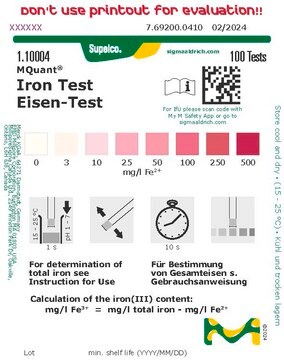455989
Potassium hexacyanoferrate(II) trihydrate
≥99.95% trace metals basis
Synonym(s):
Potassium ferrocyanide, Yellow prussiate
Sign Into View Organizational & Contract Pricing
All Photos(3)
About This Item
Linear Formula:
K4Fe(CN)6 · 3H2O
CAS Number:
Molecular Weight:
422.39
EC Number:
MDL number:
UNSPSC Code:
12352302
PubChem Substance ID:
NACRES:
NA.23
assay:
≥99.95% trace metals basis
form:
crystalline
Recommended Products
Quality Level
assay
≥99.95% trace metals basis
form
crystalline
impurities
≤500.0 ppm Trace Metal Analysis
mp
70 °C (lit.)
SMILES string
O.O.O.[K+].[K+].[K+].[K+].N#C[Fe-4](C#N)(C#N)(C#N)(C#N)C#N
InChI
1S/6CN.Fe.4K.3H2O/c6*1-2;;;;;;;;/h;;;;;;;;;;;3*1H2/q;;;;;;-4;4*+1;;;
InChI key
NRYOVBQTVIWDNU-UHFFFAOYSA-N
Looking for similar products? Visit Product Comparison Guide
Related Categories
Application
Potassium hexacyanoferrate(II) trihydrate is applied in formation of a xerogel via a cyanogel, the gel has potential use in solid-state gas sensors.
Storage Class
11 - Combustible Solids
wgk_germany
WGK 2
flash_point_f
Not applicable
flash_point_c
Not applicable
Choose from one of the most recent versions:
Already Own This Product?
Find documentation for the products that you have recently purchased in the Document Library.
Customers Also Viewed
Miljan N M Milunović et al.
Biomolecules, 10(9) (2020-08-23)
A series of four water-soluble salicylaldehyde thiosemicarbazones with a positively charged trimethylammonium moiety ([H2LR]Cl, R = H, Me, Et, Ph) and four copper(II) complexes [Cu(HLR)Cl]Cl (1-4) were synthesised with the aim to study (i) their antiproliferative activity in cancer cells
Holger Schulze et al.
Sensors (Basel, Switzerland), 21(5) (2021-04-04)
Rapid point of care tests for bacterial infection diagnosis are of great importance to reduce the misuse of antibiotics and burden of antimicrobial resistance. Here, we have successfully combined a new class of non-biological binder molecules with electrochemical impedance spectroscopy
Sharp, S.L. et al.
Chemistry of Materials, 10, 880-880 (1998)
Jorge S Valadas et al.
Neuron, 98(6), 1155-1169 (2018-06-12)
Parkinson's disease patients report disturbed sleep patterns long before motor dysfunction. Here, in parkin and pink1 models, we identify circadian rhythm and sleep pattern defects and map these to specific neuropeptidergic neurons in fly models and in hypothalamic neurons differentiated
Katlijn Vints et al.
Scientific reports, 9(1), 130-130 (2019-01-16)
Analysis of neuronal arborization and connections is a powerful tool in fundamental and clinical neuroscience. Changes in neuronal morphology are central to brain development and plasticity and are associated with numerous diseases. Golgi staining is a classical technique based on
Our team of scientists has experience in all areas of research including Life Science, Material Science, Chemical Synthesis, Chromatography, Analytical and many others.
Contact Technical Service




